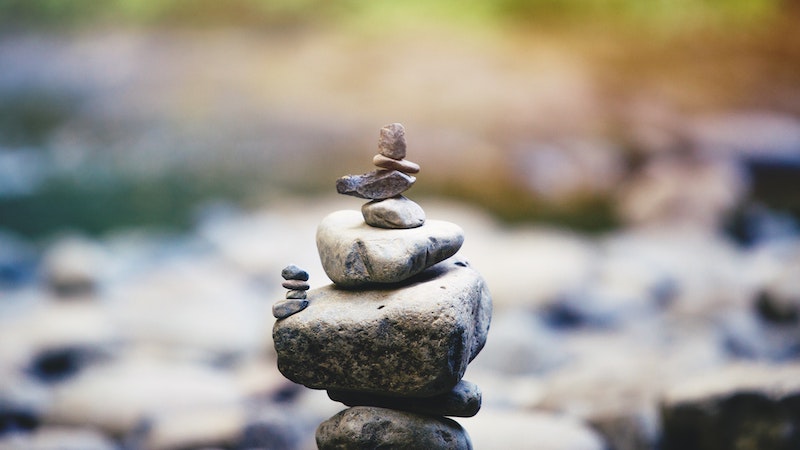Embodied Techniques for Connecting Body and Mind
Episode #3 of the course Embodied mindfulness: Tools for tuning in to your health, creativity, and purpose by Mina Samuels
Glad you’re back!
In the last lesson, we started to tune into our body-mind with a scan. Now, I’d love to introduce you to a more advanced tuning-in technique—how to use wordless sound to bring the fullness of the body and mind system online.
Sometimes I read poetry aloud to my partner. I love poetry. I love the pleasure it gives him. I also admit that I love the opportunity for the mini-performance. I mostly read electronic books now. But for our poetry custom, we need old-fashioned, hold-in-the-hand-and-turn-the-page books. Until recently, I didn’t know why I needed this tactile experience. As you’ll see, I have felt an answer.
Our practice is to read through a poet’s entire book, before moving onto the next. We have loved many collections. One of our favorites was Joy Harjo’s Conflict Resolution for Holy Beings. First off, how beautiful is that title and the idea it encapsulates—that each of us is a holy being? Indeed, this is why we are exploring how to live in a more embodied fashion. Because we know there’s more to us than what our brains tell us.
During one reading session, I came across a poem interspersed with lines of italicized words I didn’t know: Wey yo hey, wey yo hey yah /hey. As I read, a series of strong emotions swept through me—sadness, longing, love. I was a bit embarrassed. I am often overtaken by the emotion of a poem while I’m reading, but in this case, I wasn’t even reading proper words. Yet, I could feel meaning as I spoke the syllables aloud. The clumps of letters compelled me to chant.
Later that same day, reading Ursula K LeGuin’s, Always Coming Home, I came across this footnote: “This is LeGuin’s tribute to Native American tradition, in which the syllables ‘he-ya’ are common vocables, or wordless syllables. As American folklorist Barre Toelken comments on a Navajo song that is all vocables, ‘It has no words, but is all meaning.’ (The Anguish of Snails: Native American Folklore in the West, 2003).”
Understanding! The words in Harjo’s poem were vocables. Now I had a word to describe their wordlessness. The footnote went some way to explaining why I had responded with such a full-body feeling to the poem. I felt, too, how grabbing at the word, which described my experience, satisfied me intellectually but left me wanting to understand the effect of vocables at a more visceral level. No surprise there: My interest—and yours, since we are here together—is in how the entanglement of our physical and mental selves operate.
The next morning, I listened to a meditation guided by the great spiritual teacher, Thich Nhat Hanh. Our breath, he said, is how we access the oneness of our body and mind.
Aha! Now I had three points of contact with an idea, and a gut-level connection clicked into place.
Song is like breath. If there are no words, only wordless syllables, then our bodies and minds can receive the song, as breath, without judgment, without trying to figure out meaning. We can’t think our way to the answer. We have to feel. Chanted vocables enable us to access the oneness of body and mind.
I realized that I feel some part of the truth of a poem through my fingertips, such as the book in my hand, which brings me back to the particular vocables in Joy Harjo’s poem. Many of her poems have an environmental theme. Part of my experience in reading the wordless sounds aloud was an embodied, emotional consciousness of our connection with the natural world. The poet’s wordless syllables, spoken aloud, sent me out into my day just the tiniest bit more aware of my responsibilities toward the wider world.
Connect with Sound
Try it for yourself. Read these vocables aloud. Chant them, if that feels right.
Wey yo hey, wey yo hey yah /hey
Repeat. Repeat again. Notice if you feel weird or self-conscious. Can you let yourself fall into the sounds? Can you let yourself flow with a chant? Feel the words as they traverse your body. It only works if you vocalize out loud. Notice how the wordless sound accumulates inside you, connecting your body and mind.
Tomorrow, we will explore mindful movement as another tool for accessing the transformative potential of our body-mind integration.
Tune into the day!
Mina
Recommended video
Lizzo’s Tiny Desk Concert: Note the yaya-ee refrain in the last couple of minutes. Feel the freedom of her vocables. Sing along.
Recommended book
Conflict Resolution for Holy Beings by Joy Harjo
Share with friends

